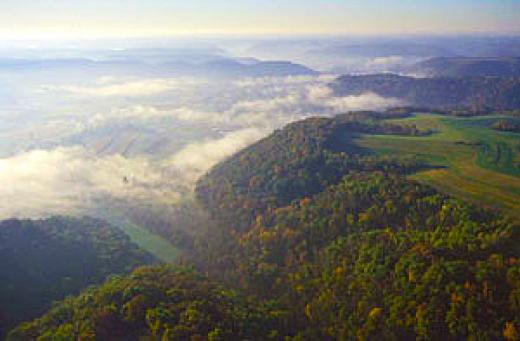Driftless Area Restoration Effort
Goals
The unique 24,000 square-mile unglaciated Driftless Area in the heart of the Upper Mississippi River basin is a natural resource treasure. The scenic landscape with its steep hills and rocky bluffs is home to one of the country’s most remarkable freshwater resources — more than 600 coldwater limestone spring-fed creeks supporting a world-class trout fishery. Over 5,700 miles of mineral-rich spring creeks weave across the landscape. These streams support abundant populations of trout, which in turn, attract tens of thousands of anglers to the region each year. A 2008 study commissioned by TU found that recreational angling in the Driftless Area generates an astounding $1.1 billion dollar annual economic benefit to local economies in Minnesota, Wisconsin, Iowa, and Illinois.
Unfortunately, early European settlement and agricultural practices took a heavy toll on the Driftless Area. The steep slopes, tight valleys and highly erosive soils were ill-suited to the intensive agricultural practices of European settlers and resulted in devastating erosion. A thick layer of deposited sediment accumulated over time, up to 15 feet of eroded soil that blanketed the valley floors. As a result, the now entrenched streams are no longer able to spread out across their floodplains to dissipate energy, resulting in continued erosion, frequent flooding, and serious damage to rivers and infrastructure in local communities.
In recent decades, conservation practices have helped control erosion on the ridges and hillsides, but streams still bear the scars of degrading land uses. In an effort to recover this unique natural resource, TU launched the Driftless Area Restoration Effort (DARE) in 2006 — a collaborative effort to restore watersheds, stream, fish and other species to benefit the environment and local communities of southwest Wisconsin, southeast Minnesota, northeast Iowa, and northwest Illinois. The goals of TUDARE are to restore watersheds and improve water quality by reducing sediment, to protect and restore habitat for fish and other non-game species and to provide recreational fishing access to restored areas. We’ve created a manual for non-game habitat development with help from our partners, which provides plans for habitat for snakes, turtles, shorebirds, waterfowl and other species, and has become the standard text in the field.
Tactics
Since most of the land in the Driftless Area is privately owned, working with landowners is essential to the success of TUDARE. When they provide a public fishing easement and allow us to carry out projects, TUDARE and its partners do the rest, without cost to landowners. We support the project’s staff budget with the help of TU chapters and state councils, individuals, businesses and foundations.
TU has raised a substantial amount of money to fund restoration work in the Driftless Area and to increase capacity of partnerships to implement on-the-ground projects in the region. As a result, more miles of stream than ever before — as many as 20 miles a year — are being restored and made available to recreational anglers. Through the efforts of TU chapters and state agencies, almost 400 more miles of public fishing access easements have been added in the three largest states than were available before the project, nearly 1,200 miles in all. Landowners donate or sell public fishing easements and we find the money for the projects from a variety of sources.
We work to train volunteers, enlist partners, encourage and share research on riparian restoration, demonstrate techniques, and develop the region’s identity through a variety of training events, workshops, tours, stream festivals and publications. We promote managed rotational grazing as an effective land use tool along restored waters.
Victories
Strong partnerships have been built with federal agencies including the U.S. Fish and Wildlife Service and the U.S. Department of Agriculture's Natural Resources Conservation Service (NRCS), state departments Strong partnerships have been built with federal agencies including the U.S. Fish and Wildlife Service and the U.S. Department of Agriculture’s Natural Resources Conservation Service (NRCS), state departments of natural resources, and county conservation departments. In addition, many projects involve local schools, colleges, and community and conservation groups which have never had an opportunity to see watershed restoration in action. TUDARE has developed manuals for best management practices for non-game species, and cooperated with prairie restoration and other wildlife groups.
TUDARE is founded on the great work and passion of TU volunteers. More than 16 chapters in and around the region have worked with agency partners to restore sections of over 150 streams. By planning and completing projects, chapters find more new members and more capacity to carry out TU’s mission. We’ve helped raise over $35 million in state, federal and private contributions for stream restoration projects. Each year, the projects restore approximately 12 to 18 miles of stream in the region. In the long run, we aim to increase that number.
We’ve organized eight stream restoration project planning workshops and have trained 500 volunteers on restoration techniques. As a result, we have seen an increase in chapters leading major restoration projects throughout the Driftless Area.
We’re also working closely with Minnesota Trout Unlimited on administering more than $15 million of sales tax revenues on over 60 stream restoration projects in the state.
Throughout the history of TUDARE, federal Farm Bill conservation programs have played a major role in funding projects. In 2013 the proposal Driftless Area Conservation Landscape Initiative was approved and almost $3 million was awarded to private landowners for conservation in the first round of funding. Another recent grant from NRCS will provide over $5 million for restoration and managed grazing projects in the Kickapoo River Valley in Wisconsin, as part of the USDA’s Mississippi River Basin Initiative.
Staff Contact
Jeff Hastings, Project Manager
jhastings@tu.org
Duke Welter, Outreach Coordinator
DWelter@tu.org
Paul Krahn, Stream Restoration Specialist
pkrahn@tu.org
Author of this Page
Jeff Hastings




